Page 165 of 569
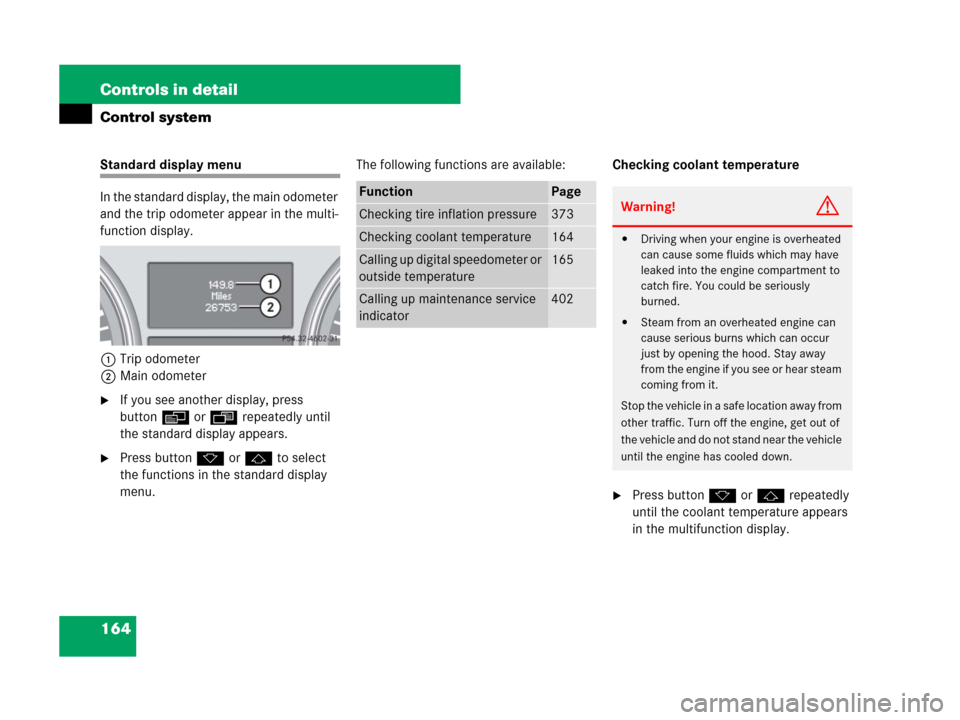
164 Controls in detail
Control system
Standard display menu
In the standard display, the main odometer
and the trip odometer appear in the multi-
function display.
1Trip odometer
2Main odometer
�If you see another display, press
buttonè orÿ repeatedly until
the standard display appears.
�Press buttonkorj to select
the functions in the standard display
menu.The following functions are available:Checking coolant temperature
�Press buttonk orj repeatedly
until the coolant temperature appears
in the multifunction display.
FunctionPage
Checking tire inflation pressure373
Checking coolant temperature164
Calling up digital speedometer or
outside temperature165
Calling up maintenance service
indicator402
Warning!G
�Driving when your engine is overheated
can cause some fluids which may have
leaked into the engine compartment to
catch fire. You could be seriously
burned.
�Steam from an overheated engine can
cause serious burns which can occur
just by opening the hood. Stay away
from the engine if you see or hear steam
coming from it.
Stop the vehicle in a safe location away from
other traffic. Turn off the engine, get out of
the vehicle and do not stand near the vehicle
until the engine has cooled down.
Page 170 of 569
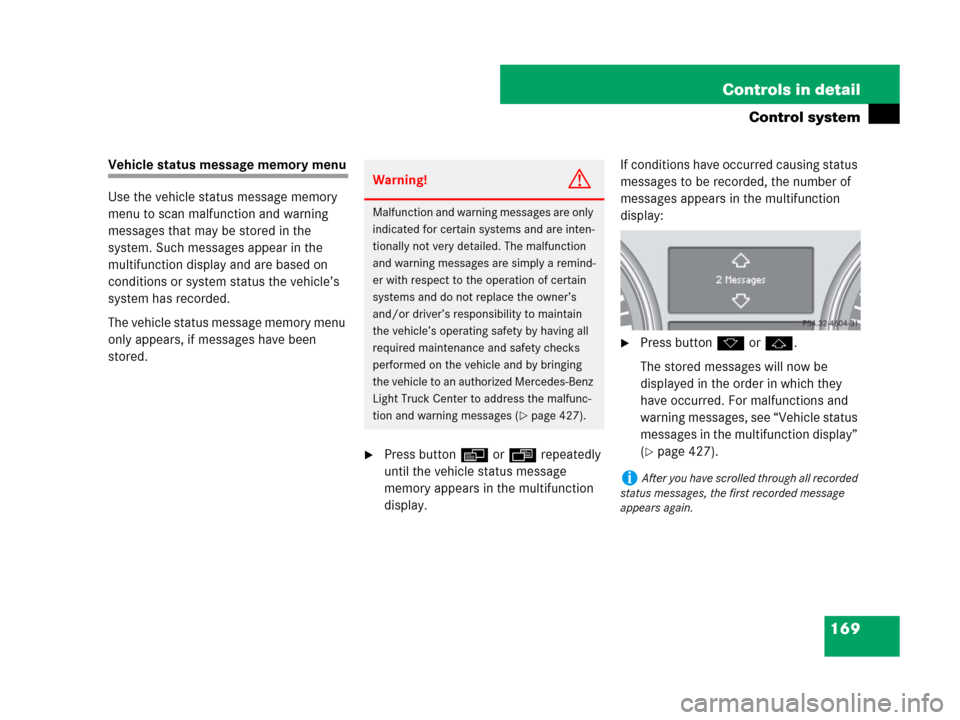
169 Controls in detail
Control system
Vehicle status message memory menu
Use the vehicle status message memory
menu to scan malfunction and warning
messages that may be stored in the
system. Such messages appear in the
multifunction display and are based on
conditions or system status the vehicle’s
system has recorded.
The vehicle status message memory menu
only appears, if messages have been
stored.
�Press buttonè orÿ repeatedly
until the vehicle status message
memory appears in the multifunction
display.If conditions have occurred causing status
messages to be recorded, the number of
messages appears in the multifunction
display:
�Press buttonk orj.
The stored messages will now be
displayed in the order in which they
have occurred. For malfunctions and
warning messages, see “Vehicle status
messages in the multifunction display”
(
�page 427).
Warning!G
Malfunction and warning messages are only
indicated for certain systems and are inten-
tionally not very detailed. The malfunction
and warning messages are simply a remind-
er with respect to the operation of certain
systems and do not replace the owner’s
and/or driver’s responsibility to maintain
the vehicle’s operating safety by having all
required maintenance and safety checks
performed on the vehicle and by bringing
the vehicle to an authorized Mercedes-Benz
Light Truck Center to address the malfunc-
tion and warning messages (
�page 427).
iAfter you have scrolled through all recorded
status messages, the first recorded message
appears again.
Page 338 of 569
337 Operation
The first 1 000 miles (1 500 km)
Driving instructions
At the gas station
Engine compartment
Tires and wheels
Winter driving
Maintenance
Vehicle care
Page 340 of 569
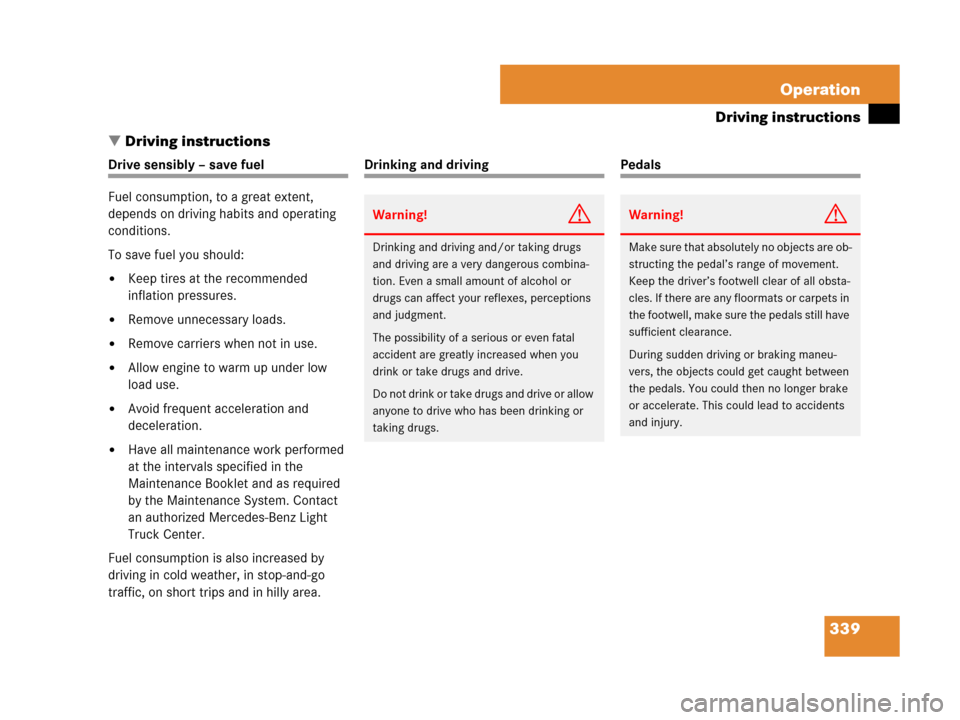
339 Operation
Driving instructions
�Driving instructions
Drive sensibly – save fuel
Fuel consumption, to a great extent,
depends on driving habits and operating
conditions.
To save fuel you should:
�Keep tires at the recommended
inflation pressures.
�Remove unnecessary loads.
�Remove carriers when not in use.
�Allow engine to warm up under low
load use.
�Avoid frequent acceleration and
deceleration.
�Have all maintenance work performed
at the intervals specified in the
Maintenance Booklet and as required
by the Maintenance System. Contact
an authorized Mercedes-Benz Light
Truck Center.
Fuel consumption is also increased by
driving in cold weather, in stop-and-go
traffic, on short trips and in hilly area.
Drinking and drivingPedals
Warning!G
Drinking and driving and/or taking drugs
and driving are a very dangerous combina-
tion. Even a small amount of alcohol or
drugs can affect your reflexes, perceptions
and judgment.
The possibility of a serious or even fatal
accident are greatly increased when you
drink or take drugs and drive.
Do not drink or take drugs and drive or allow
anyone to drive who has been drinking or
taking drugs.
Warning!G
Make sure that absolutely no objects are ob-
structing the pedal’s range of movement.
Keep the driver’s footwell clear of all obsta-
cles. If there are any floormats or carpets in
the footwell, make sure the pedals still have
sufficient clearance.
During sudden driving or braking maneu-
vers, the objects could get caught between
the pedals. You could then no longer brake
or accelerate. This could lead to accidents
and injury.
Page 350 of 569

349 Operation
Driving instructions
Catalytic converter (gasoline engine)
Your vehicle is equipped with
monolithic-type catalytic converters, an
important element in conjunction with the
oxygen sensors to achieve substantial
control of the pollutants in the exhaust
emissions. Keep your vehicle in proper
operating condition by following our
recommended maintenance instructions
as outlined in your Maintenance Booklet.Oxidation catalyst (diesel engine)
Your vehicle is equipped with an oxidation
catalyst, an important element in conjunc-
tion with the oxygen sensors to achieve
substantial control of the pollutants in the
exhaust emissions. Keep your vehicle in
proper operating condition by following
our recommended maintenance instruc-
tions as outlined in your Maintenance
Booklet.
!To prevent damage to the catalytic convert-
ers, use only premium unleaded gasoline in this
vehicle.
Any noticeable irregularities in engine operation
should be repaired promptly. Otherwise,
excessive unburned fuel may reach the catalytic
converter, causing it to overheat and potentially
start a fire.
Warning!G
As with any vehicle, do not idle, park or op-
erate this vehicle in areas where combusti-
ble materials such as grass, hay or leaves
can come into contact with the hot exhaust
system, as these materials could be ignited
and cause a vehicle fire.
Warning!G
As with any vehicle, do not idle, park or
operate this vehicle in areas where combus-
tible materials such as grass, hay or leaves
can come into contact with the hot exhaust
system, as these materials could be ignited
and cause a vehicle fire.
Page 351 of 569
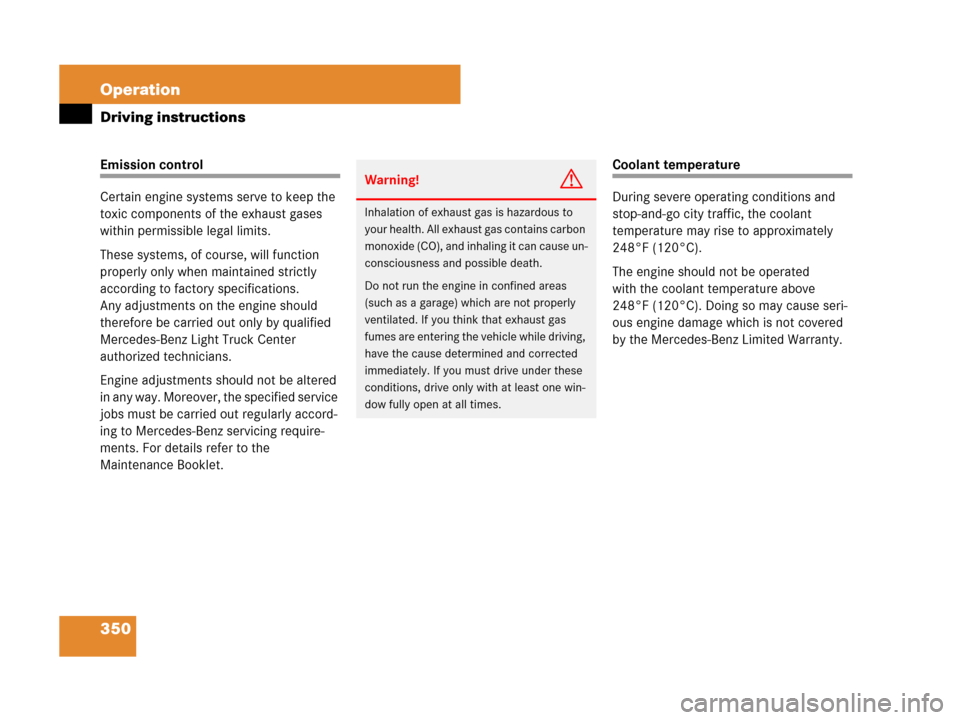
350 Operation
Driving instructions
Emission control
Certain engine systems serve to keep the
toxic components of the exhaust gases
within permissible legal limits.
These systems, of course, will function
properly only when maintained strictly
according to factory specifications.
Any adjustments on the engine should
therefore be carried out only by qualified
Mercedes-Benz Light Truck Center
authorized technicians.
Engine adjustments should not be altered
in any way. Moreover, the specified service
jobs must be carried out regularly accord-
ing to Mercedes-Benz servicing require-
ments. For details refer to the
Maintenance Booklet.Coolant temperature
During severe operating conditions and
stop-and-go city traffic, the coolant
temperature may rise to approximately
248°F (120°C).
The engine should not be operated
with the coolant temperature above
248°F (120°C). Doing so may cause seri-
ous engine damage which is not covered
by the Mercedes-Benz Limited Warranty.
Warning!G
Inhalation of exhaust gas is hazardous to
your health. All exhaust gas contains carbon
monoxide (CO), and inhaling it can cause un-
consciousness and possible death.
Do not run the engine in confined areas
(such as a garage) which are not properly
ventilated. If you think that exhaust gas
fumes are entering the vehicle while driving,
have the cause determined and corrected
immediately. If you must drive under these
conditions, drive only with at least one win-
dow fully open at all times.
Page 360 of 569

359 Operation
Engine compartment
�Wipe oil dipstick 1 clean.
�Fully insert oil dipstick1 into the
dipstick guide tube.
�Pull out oil dipstick1 again after
approximately 3 seconds to obtain
accurate reading.
The oil level is correct when it is between
lower mark 3 (min.) and upper mark 2
(max.) of the oil dipstick.
�If necessary, add engine oil.
For more information on engine oil, see
“Technical data” section (
�page 536) and
(
�page 538).
For information on messages in the multi-
function display concerning engine oil, see
the “Practical hints” section (
�page 451).Adding engine oil
Example illustration R 350 4MATIC
1Filler cap
�Unscrew filler cap1 from filler neck.
�Add engine oil as required. Be careful
not to overfill with oil.
iThe filling quantity between the upper and
lower marks on the oil dipstick is approximately
2.1 US qt (2.0 l).
!Only use approved engine oils and oil filters
required for vehicles with Maintenance System.
For a listing of approved engine oils and oil
filters, refer to the Factory Approved Service
Products pamphlet (USA only) in your vehicle
literature portfolio, or contact an authorized
Mercedes-Benz Light Truck Center.
Using engine oils and oil filters of specification
other than those expressly required for the
Maintenance System, or changing of oil and oil
filter at change intervals longer than those called
for by the Maintenance System will result in
engine or emission control system damage
not covered by the Mercedes-Benz Limited
Warranty.
��
Page 365 of 569
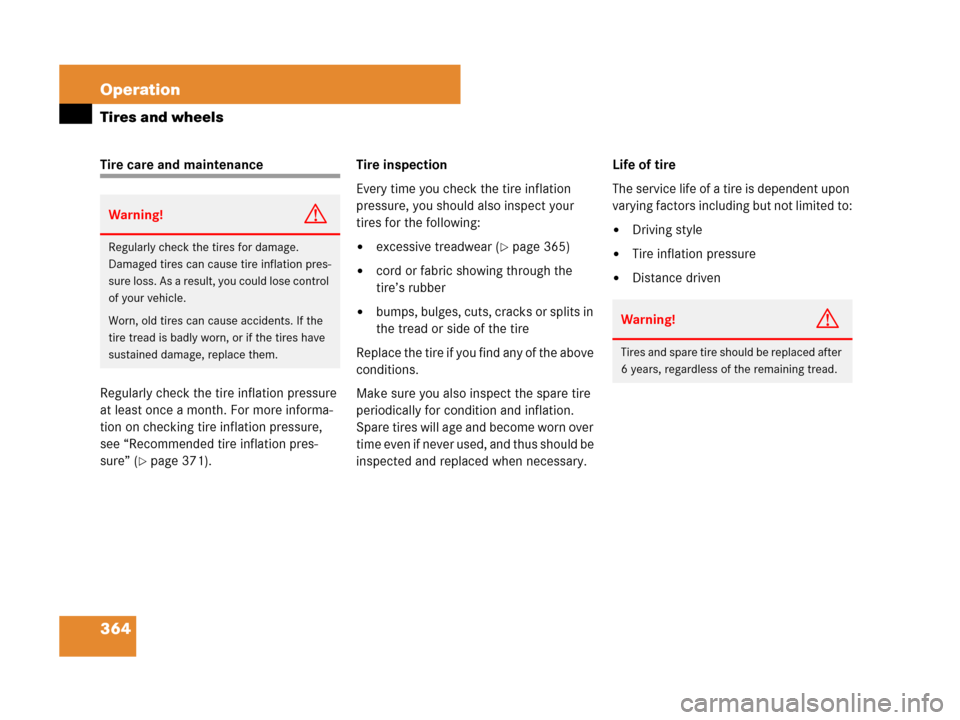
364 Operation
Tires and wheels
Tire care and maintenance
Regularly check the tire inflation pressure
at least once a month. For more informa-
tion on checking tire inflation pressure,
see “Recommended tire inflation pres-
sure” (
�page 371).Tire inspection
Every time you check the tire inflation
pressure, you should also inspect your
tires for the following:
�excessive treadwear (�page 365)
�cord or fabric showing through the
tire’s rubber
�bumps, bulges, cuts, cracks or splits in
the tread or side of the tire
Replace the tire if you find any of the above
conditions.
Make sure you also inspect the spare tire
periodically for condition and inflation.
Spare tires will age and become worn over
time even if never used, and thus should be
inspected and replaced when necessary.Life of tire
The service life of a tire is dependent upon
varying factors including but not limited to:
�Driving style
�Tire inflation pressure
�Distance driven
Warning!G
Regularly check the tires for damage.
Damaged tires can cause tire inflation pres-
sure loss. As a result, you could lose control
of your vehicle.
Worn, old tires can cause accidents. If the
tire tread is badly worn, or if the tires have
sustained damage, replace them.
Warning!G
Tires and spare tire should be replaced after
6 years, regardless of the remaining tread.